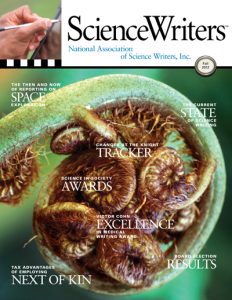Acknowledging funding sources benefits everyone
By Allison Eckhardt
PIOs and their colleagues might have noticed a push NIH recently made to reinforce the requirement that grantee institutions provide acknowledgement of federal funding in press releases, stories, and other publicly facing items. Some of you may also have heard from NIH lately about including grant numbers in press releases and similar materials, too. Both are part of an effort by NIH to better tell the story about federal investment in research in ways that can be understood by nonscientists. Here’s what these projects are all about.
In today’s funding climate, federal agencies like the National Institutes of Health, the Department of Energy, and the National Science Foundation are constantly under siege from budget-cutting efforts. NIH alone funded 44,642 grants in 2011, and wants to continue supporting innovative research.Unfortunately, the message that federal dollars helped support those researchers at institutions across the country does not come across to the people who make budget decisions. If you were to ask someone on the street who paid for the research going on at a local university, her response is almost assuredly the school, the state, or maybe even a private foundation. Federal PIOs struggle to make the connection between research and the money that made it happen. We need decision leaders to realize where the funding actually originated so they don’t cut those sources — our budgets — allowing us to continue to fund our universities and research institutions.
NIH is implementing an existing agreement — required by statute for more than a decade — that all investigators (or their grants offices) sign when they accept our money. In the past, PIs were aware that they should include the funding institution on their papers, presentations, and other publications, and many journals now also require this. But few PIs or PIOs know that news releases and stories are also included on the list of publications that require acknowledgement, and that it’s also a statutory requirement.
The grant number issue isn’t in statute, but NIH will be including this language going forward in the notices of award to investigators. In addition to asking our grantees to mention that the funding came from NIH, we are also asking that the project numbers for the grants that supported the research be included. Why? We are using the project number to link news releases to our publicly available grant database, RePORTER (projectreporter.nih.gov). Currently, any information on projects at grantee institutions in this public and frequently consulted database was provided by the researcher as the abstract to a grant application and, to be charitable, usually was not written for public consumption. By linking well-written public releases and stories to the database, reporters, Congressional staff, and the public can read a wonderfully crafted narrative about the project and hopefully better understand the science our grantee institutions do.
There are limitations to this system: We can’t link to PDFs and each release or story that we link to has to have its own URL to prevent confusion when multiple stories are told in a single document, such as annual reports. But we are constantly working to make the project as efficient and easy for PIOs as possible. We recently collaborated with EurekAlert! to add a grant number section to their submission form — if you include the grant number and the funding institution, it automatically populates to our grant database and absolves you of any need to include the grant number in the body or boilerplate for the release or story.
Another important reason to include funding information in releases is transparency. Taxpayers — and increasingly reporters — are calling for more openness in how research is funded and conducted. Who thought this project was important enough to fund? Did a pharmaceutical company lend support? Where might someone look for similar projects? Telling our audiences the funding source is an act of openness. The vast majority of research today is conducted with outside sponsorships of one kind or another, and we should make it standard practice to include the funder up front, in the release or in its boilerplate.
In short, our goal in recognizing funders, and in associating your news stories with the grants database, in news and web materials is two-fold: not only does it reinforce the importance of federal funding to research progress, it gives readers and policymakers important context about the project and about the grantee institution. We hope you agree, and will help make our project successful and link the dollars to the research. For more information on NIH’s funding acknowledgement initiative, contact the PIO network at pio@nih.gov.
Allison Eckhardt is public affairs specialist at the National Cancer Institute (National Institutes of Health) and can be reached at allison.eckhardt@nih.gov.

